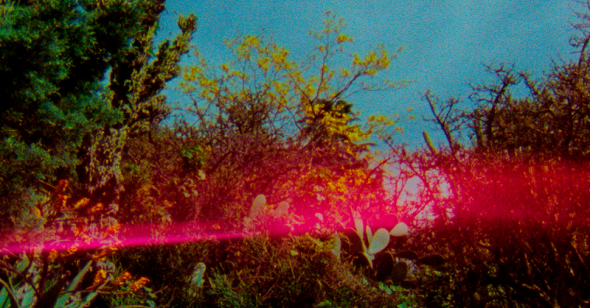Shelf Life
by Chris Shields
Herbaria
Leandro Listorti, Argentina/Germany, no distributor
Leandro Listorti’s new film, Herbaria, offers audiences a unique meditation on extinction and preservation in the twinned worlds of plants and film. Shot on 35mm and 16mm, this mysterious, at times cryptic, essayistic work takes viewers to two locations: the seemingly disparate Buenos Aires Botanical Garden and the Museo del Cine. The film opens a window onto Argentina’s filmic and botanical past, mixing archival footage and poetic reverie with documentary techniques to present preservation and disintegration in a haunting and profound light.
Herbaria begins in a more traditional nonfiction mode, as a group of people search a wooded area for plant specimens. Figures move through the dense, anonymous brush in a wide shot before we see one particular plant uprooted, delicately placed in newspaper and pressed flat, ostensibly for preservation and storage purposes. Another wide shot coolly takes in the stillness of the forest before the screen is suddenly filled with a staccato blast of heavily damaged, early film imagery—discolored and fragmented, boasting its own distressed beauty.
The film then moves to a quiet, brightly lit room where plants are cataloged. While the camera focuses on the details of leaves and stems being pressed flat and fastened to backboards before being filed away, title cards elucidate the historical extinction of plant life—since the mid-18th century more than 500 species of plants have disappeared—and how the Buenos Aires herbarium came to have such a notable collection of specimens. Later, in the film’s closing minutes (an almost perfect mirror image of the earlier title card), we learn that silent films have suffered a similar fate, with an estimated 80 to 90% no longer extant.
As the film goes on, it finds an increasing amount of common ground between its dual subjects through direct paralleling and digressions concerning more tangential affinities. We see early naturalist documentaries that invite us to experience plants as both botanical documents and early works of cinema. We learn that famed Argentine naturalist Cristobal Hicken, for whom the Buenos Aires Gardening School is named, was the uncle of Pablo Hicken, for whom the Film Museum of Buenos Aires (a large and vital collection of antique film equipment) is named. Herbaria presents a strange yet compelling cross-pollination of history and ideas, nourished by the film and the consideration we’re invited to give them.
Listorti, who has also worked in the worlds of programming and archiving, regards his latest film as his most personal. Herbaria takes us into an environment with which the director is intimately familiar, where plants and film are painstakingly preserved. There, he invites us to silently observe this quietly meticulous process. As the film’s somber reflection on the Sisyphean task of keeping the memory of a disappearing world alive slowly takes shape, archivists and preservationists become nameless protagonists fighting an unwinnable war against time.
Rather than being guided by a strict narrative thrust, Herbaria evokes, in its flow of images, the feeling of a leisurely afternoon comfortably spent among books. In this world of archives and materials, things contain historical and ideological meanings that may point beyond themselves but also offer their own aesthetic and experiential pleasures; a plant, a film, a photo, a yellowed index card can be both subject and the object.
Herbaria itself represents the instantiation of this idea, existing somewhere between document and meta document. Listorti shows us images of plant life, architecture, and preservation activities with graceful pans and long takes, while his film documents its own reality as an impermanent object, achieving a sense of reflexivity through the use of rollouts, heavily damaged and degraded filmstock, and the aforementioned archival footage. Despite this aesthetic enjoyment of film’s more corruptible qualities, the medium is seen as a type of chrono-sanctuary, a place where time works differently and the past might be preserved in an imperfect but meaningful form.
In the film’s final minutes, we learn that identifying and cataloging methods for plants (the physical process we’ve witnessed throughout the film) have remained unchanged for the last 200 years. We then learn that film, if properly stored, has a useful shelf life of 500 years or more. In fact, in ideal conditions film (rather than digital) could be a viable tool for long-term archiving of moving images. With this, the film seems to hint at a possible convergence and transformation of how we think about and approach preservation. While unable to preserve the desiccated physical form of plant life, film is uniquely suited to capturing and documenting our experience of plants and their perceptible characteristics. Herbaria enacts this very concept in its attention to and mingling of historical fact, ideas, fantasy, and aesthetic pleasure—showing us how we might preserve memories of our disappearing world and what these transmuted documents might look like. Ultimately, there is something Borgesian in this vision of things and their taxonomy as both practical and metaphysically beautiful: the film seems to share in the Argentine librarian and author’s imagining that, “Paradise will be a kind of library.”
